I went to Tulbagh in late August. Here are some photos of buildings I saw there with notes about them & a few other things.

The VOC authorities did not want the Cape to develop into anything more than a small station to replenish the food & water supplies of their trading ships. Their requirement for meat resulted in expansion of the settlement; the local cattle & sheep herders (khoisan) were reluctant to trade breeding stock. In 1658 a party was sent out from the fort to try and barter for cattle, one of that party got to see the Tulbagh valley (initially known as Roodezand) but it appeared to be uninhabited to him. Forty years later (1699) the next traveller to see the valley was Governor Willem Adriaan van der Stel. It created a very good impression upon him and he arranged for settlers to be sent there in 1700.
This was the beginning of white settlement in the valley. In 1743 a church was built. A parsonage (pastorie) and house for the sexton were also built but there were no other residents around the church – it served the local farmers who had had to travel to Paarl previously for church. Fifty years later in 1794 the church was too small for the local farming community of about 40 families so the church had to be enlarged. To fund this they got a surveyor in who laid out a row of erven along the track from the pastorie to the church. These were offered for sale & the money raised used to pay for the additions to the church. (This became a common practice for church towns thereafter.) In 1803 there were 12 houses on this road.
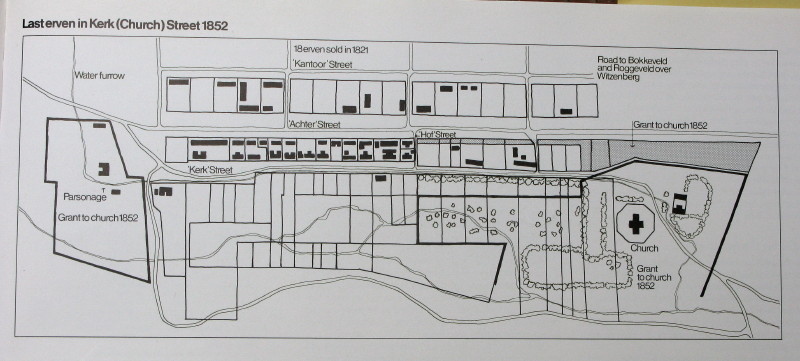
In this picture you see the church on the right and the parsonage (pastorie) on the left with Kerkstraat joining the two. The plan is for about 1852; the town had expanded into another street (Achterstraat) by then. The two houses on the right are not aligned to the street. The twelve houses facing Kerkstraat had gardens running right down to the river – in those days you had to provide your own food & that included the predikant who had quite a decent sized piece of land at the pastorie.
So those houses date from about 1800 and were built of local materials. The authorities built a Drostdy (magistrates Court) in 1804; this was the second one outside Cape Town (Stellenbosch was the first). The British took over control at the Cape in 1806 and one of their Governors founded a new settlement at Worcester in 1818 and built a Drostdy there – but it was a sub-Drostdy to the main one in Tulbagh. In 1822 the Drostdy in Tulbagh was damaged in a violent storm & the Governor used that as a pretext to close it & make Worcester the only Drostdy in the area. This had a stultifying effect on the development of Tulbagh so little happened there and the town was preserved much as it had been. In 1969 there was quite a severe earthquake that badly damaged many of the buildings in the area. Because of its history the layout of the town was very much as it had been though the buildings had been altered over the years. Architect & architect historian Gawie Fagan & Hans Fransen were very aware of the preserved nature of the town & they rushed out there the next day to see what had happened. They quickly realised that with the financial support of Anton Rupert and a specially formed Restoration Committee there was a real possibility of rebuilding Kerkstraat to be a faithful representation of what the buildings had looked like before.
I was very fortunate to have gone there last Saturday with the VERNACS (Vernacular Architecture Society of South Africa = Volksboukundige Vereeniging van Zuid Afrika) and both Hans & Gawie were there. I want to show what the buildings look like now 40 years later.
I will show photos of each building and add a little note about them. I am going to go through the buildings by street number, starting from the church end at the south. It will be a bit like a stroll down the street with me saying something about each building. We were there in the morning so the sun was behind the gables I assumed that all that would really show in the pictures was the outline of a dark shaded building against the bright sunlit sky behind. In fact modern digital photography is able to show both the bright sky and a surprising amount of the detail in the shaded part of the building we are looking at. I had expected to have to simply write about the shape of the gables but now i need to do quite a bit more than that. We (Antonia & I) have ’Church Street in the Land of Waveren’ by Gawie & Gwen Fagan so I can tell you what the buildings looked like before they restored them.
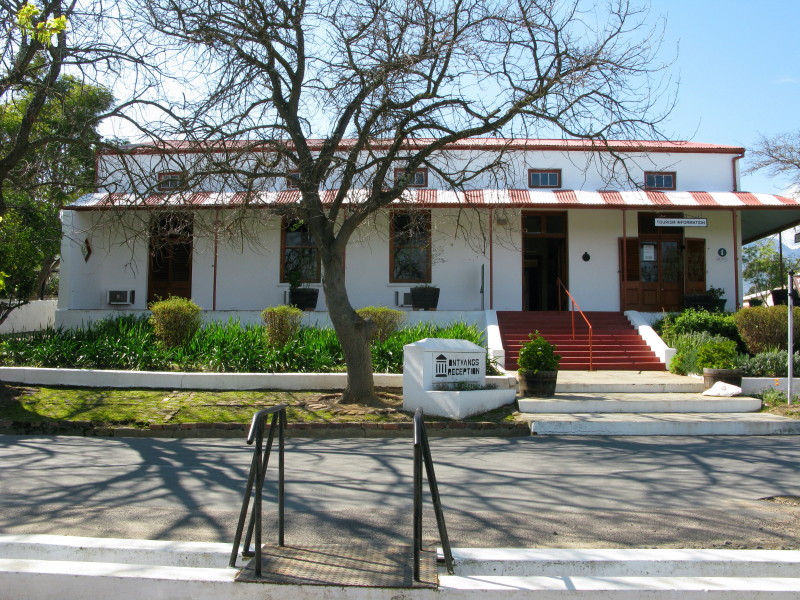
#4. This house was built in the Victorian style shortly before 1800. It is a good example of the style earlier buildings in the street were changed to when their thatch roofs were replaced with corrugated iron and ogee (s shaped) corrugated iron roofs added to the stoep. What you see here looks just like the original building. This building is now the museum with photographs of the history of the town & area. The old church opposite is also part of the museum with interesting things in it. I will discuss it & some of the contents later in this thread.
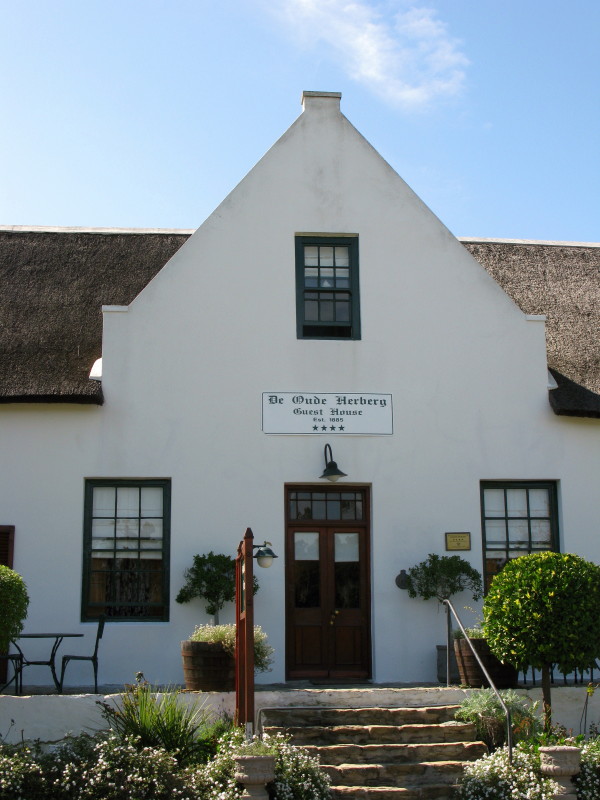
Here is a very simple gable. Gawie Fagan restored the buildings faithfully according to this photo in the museum:
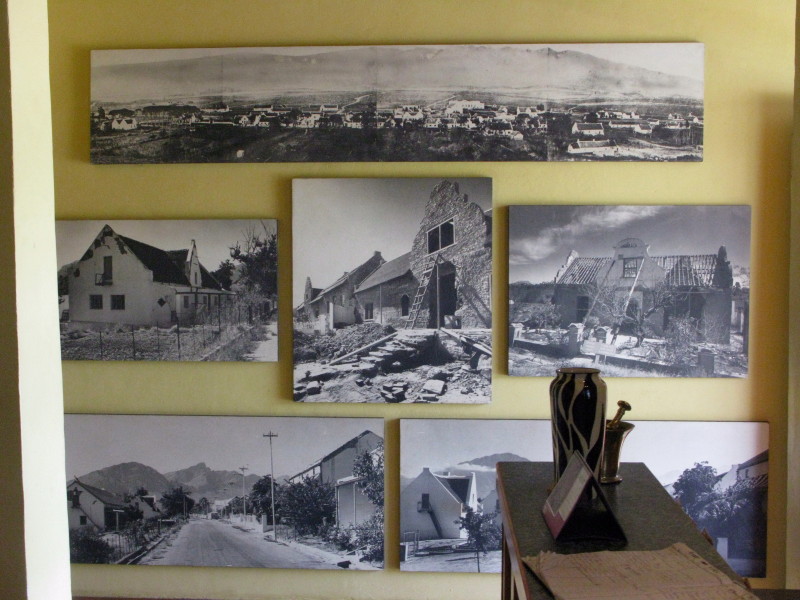
That top photo was taken in 1861. #6 is just about on the picture at the right. Below it you can see photos of the rebuilding of some of the houses; notice that they remove all the plaster so they can see where the original windows and doors were and their true size from the brickwork. There were seven houses with this plainest of gables in Tulbagh. It was an utterly characterless corrugated iron roofed house without even the loft windows like a shed before the earthquake.
#8 Demolished
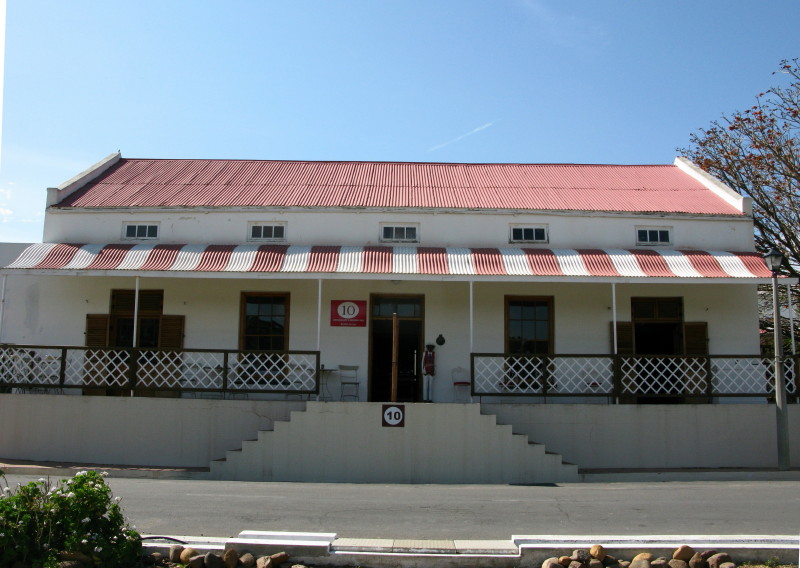
#10
Very similar to #4 in how it has been restored. This building survived quite well structurally. It had an awful stoep with ‘60s steel welded handrails and those concertina aluminium sun blinds over each of the windows. In this case there are gables on the ends sticking above the corrugated iron roof level. Now it has a nice ogee corrugated iron stoep roof with elegant thin columns. #8 had thick round concrete pillars, a flat stoep roof and a brick wall along the street. This style is much lighter and friendlier than that the old one used to be.
The houses down this end of Kerkstraat were the last to be built. No 10 was built in about 1880 with a corrugated iron roof and sliding sash windows just as you see it here.
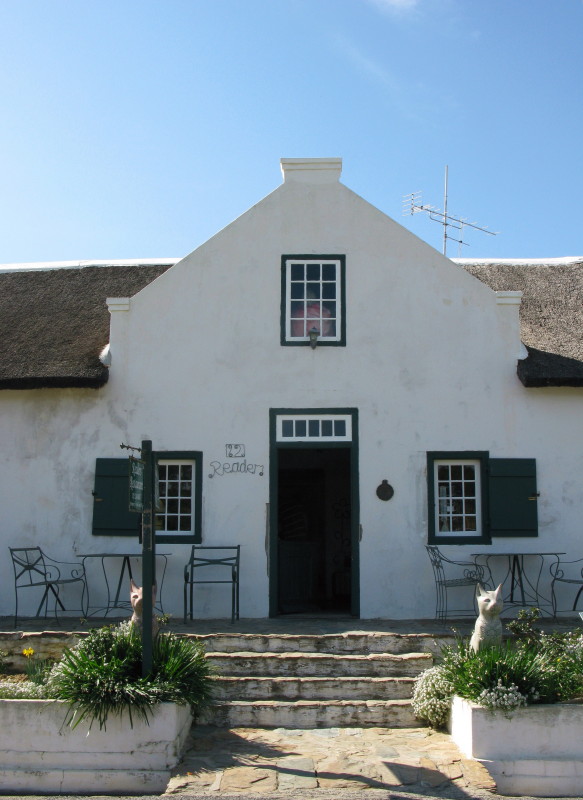
#12 = Readers This was the first house built on Kerk Straat and does not line up properly with the street in front. This means it is probably there before the street was laid out; a useful clue for spotting old buildings in our dorps. It had been completely Victorianised but Gawie could get a very good idea of how it originally looked from the photo. Structurally it was in quite good condition. It has been restored to what it looked like before it was Victorianised. Again it has a fairly simple gable over the front door but notice that the straight sides of the gable go above the eaves level of the thatch roof.
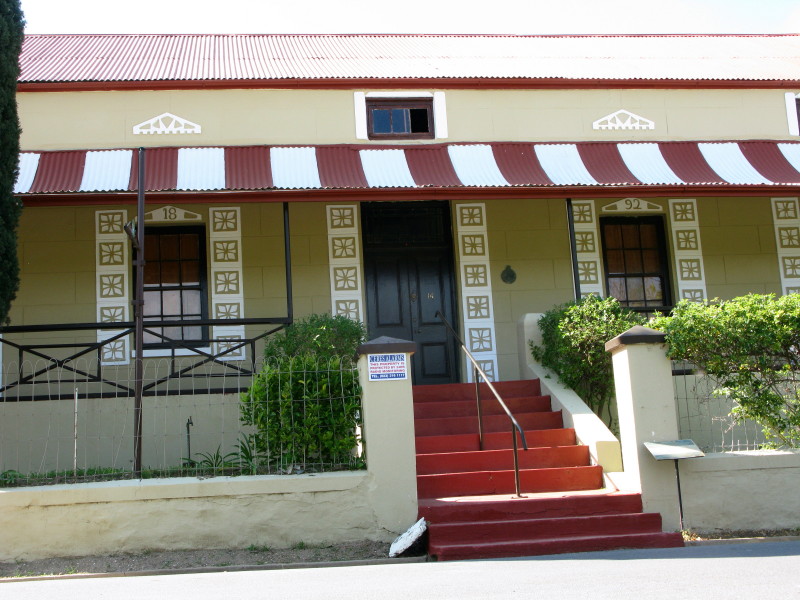
#14 This house was the last to be built on the upper (east) side of Kerk Straat. See the date 1892 above the windows. Queen Victoria ruled from 1837 till 1901 (longest reign of any British monarch) so this building was built well in the Victorian era. In restoring it all they did was replace the thin posts for the stoep roof (they had been bricked in). Lovely plaster decoration around the windows & doors and between the loft windows. This is the fashion that was used when the older buildings were modernised. Please notice the colours that have been used. There is a Pierneef watercolour picture of this house & it served as the basis for what you see here. The tyranny of white on all old buildings is a false practice.
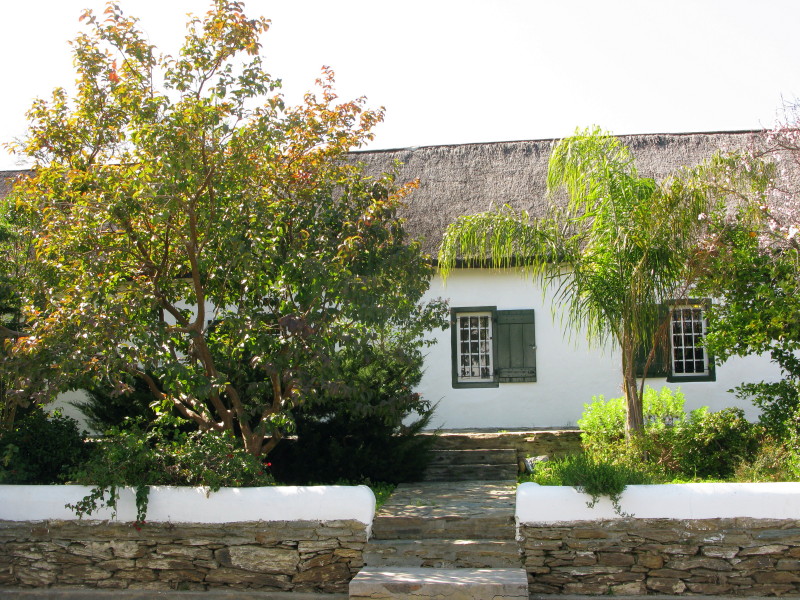
#16 You can’t see this house because of the trees. Originally it was a wagon shed then became two joined rental houses. It has been restored to the simple house as it was after the original conversion. It has two front doors and no gables. It is now white but they round yellow ochre as the original colour under the whitewash when they did the restoration so it was painted that colour but has since been changed.
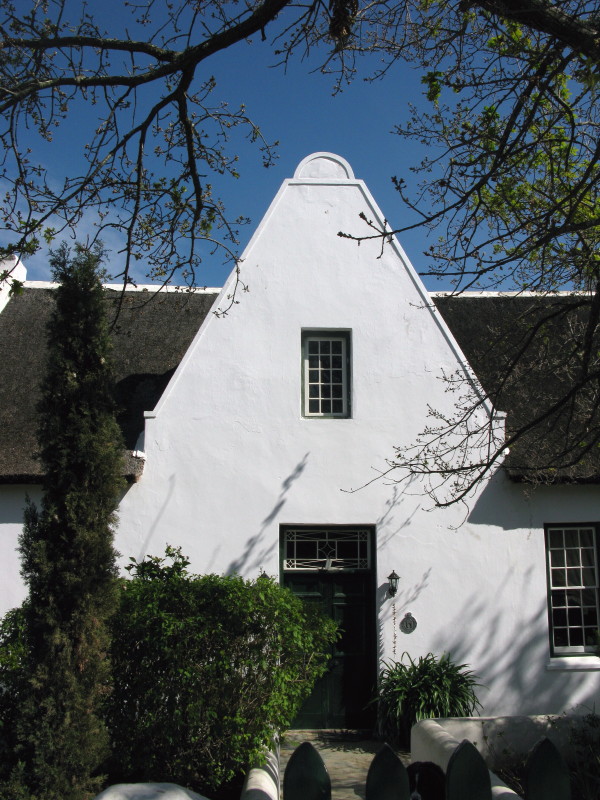
#17 An odd street number so it is on the west (river) side of Kerkstraat. Built in 1852 in the then current very steeply pitched thatch roof style. It had been converted to a corrugated iron roofed characterless house. Gawie chose to restore it to look just like the original building. I really like this unusually tall narrow gable. Probably because it is unusual and so simple is what attracts me to it. Notice the nice fanlight over the front door.
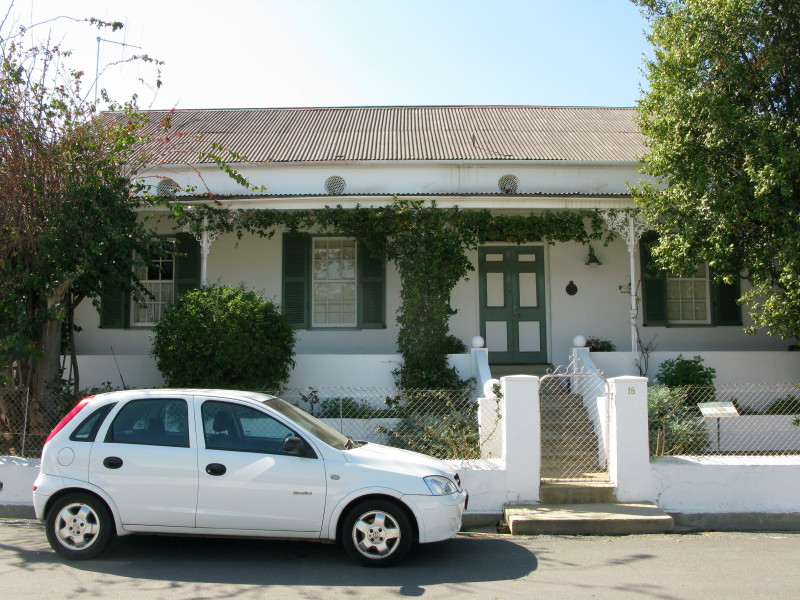
#18 Not much was done here during restoration. The original house is thought to have been built about 1891. It was the blacksmiths workshop for 40 years up until 1970 (most of the ironwork used in the restoration of Kerkstraat was forged right here). The brick pillars were replaced with Victorian cast iron with broekies lace only at the top of the pillars. The steel windows were replaced with wooden sliding sash ones.
#20 was demolished & the old stable was converted into public toilets. The local council has sold the land and toilets to a developer!
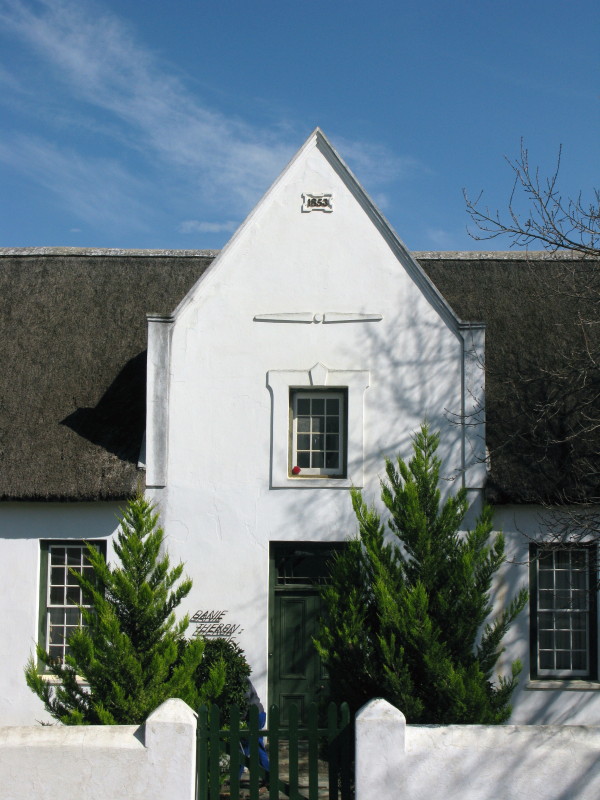
#21 Odd number so on the ‘other’ side of the street. Another simple gable, but look at it. It has straight sides going up past the thatch eaves. The date on the gable is 1853. The book says the gable was enlarged three times – presumably based on the brickwork under the plaster when they removed it. This information is a caption to a photo of the stripped gable, but they don’t say any more.
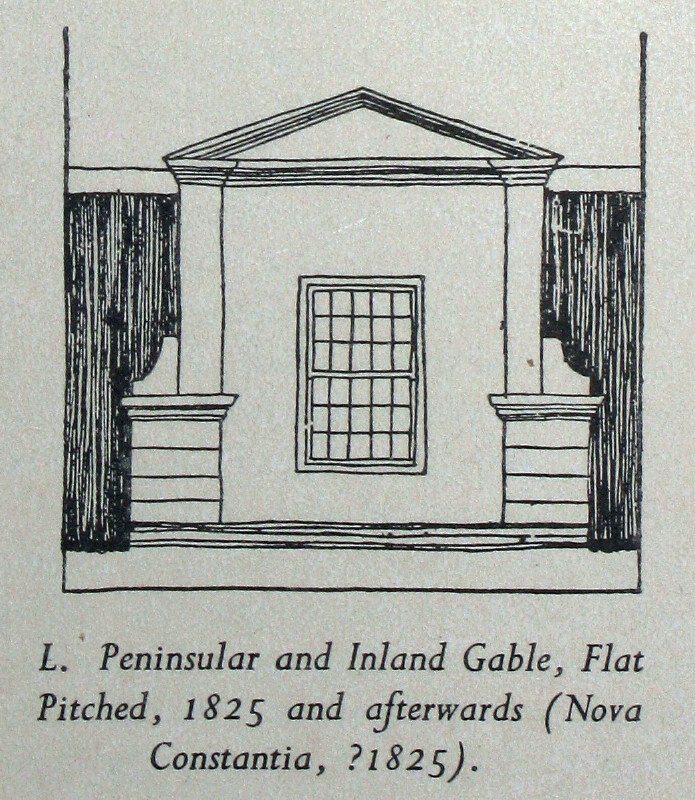

These two diagrams from ’Cape Dutch Houses and Farms’ by C. De Bosdari shows the development from beginnings such as this. The Classical style was that developed by the Greeks as used in their temples. Wiki entry This building has that reduced to its simplest form. I think it is handsome. Later on these neo-classical gables developed into extremely elaborate examples.
Here is a picture of a building in the neo-classical style; Jameson Hall at UCT (built 1929?)
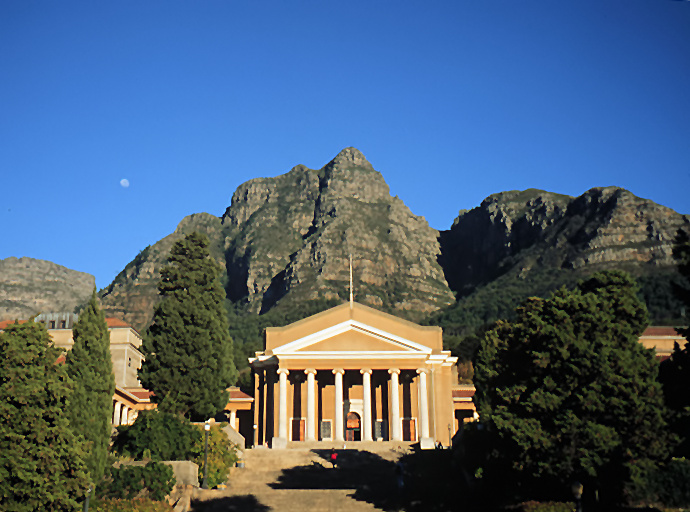
Notice the triangular pediment and columns; just like a Greek temple.
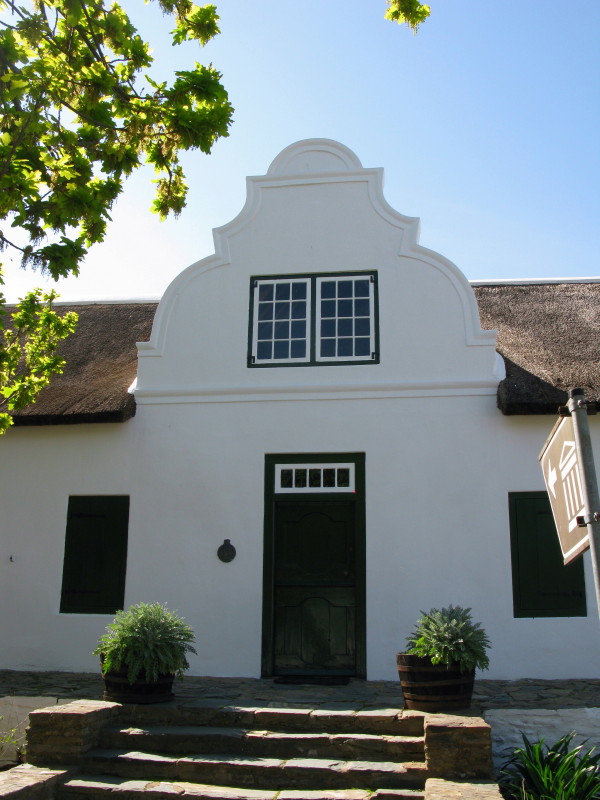
#22 The absolute classic gable shape in my opinion. This style of gable is called the Holbol . We now have reached the buildings on the first erven to be sold, in 1796, to fund the extension of the church. These buildings have the older style gables which are, to me, the more attractive ones.
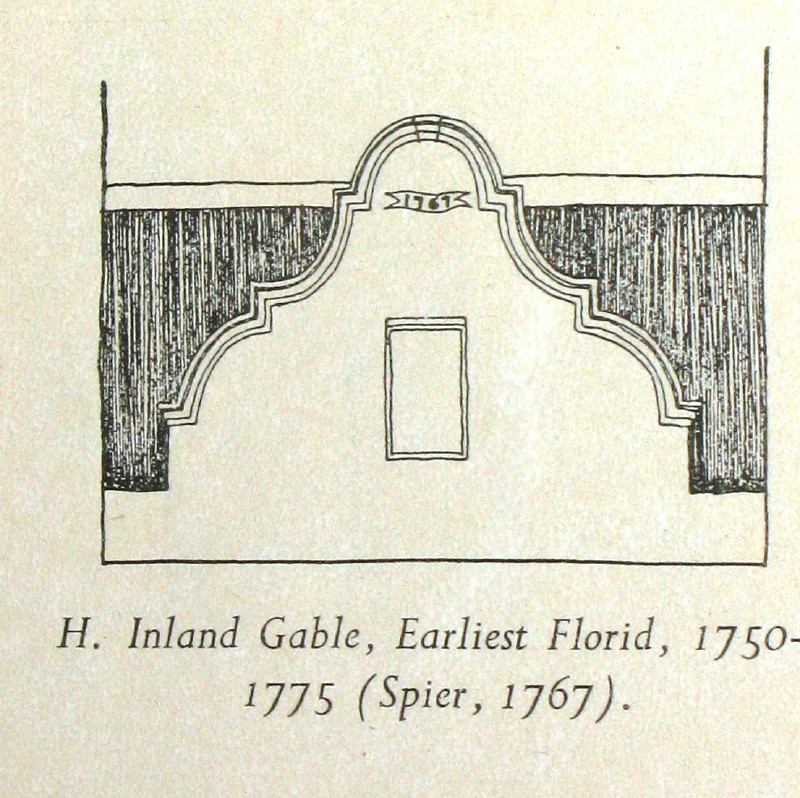
The builder/plasterer has made his own variation on the theme here because the little vertical bit between the hol & bol slopes outwards a little and the hols are bigger than the bols. This house had not been Victorianised. It was repaired and the roof over the stoep was removed
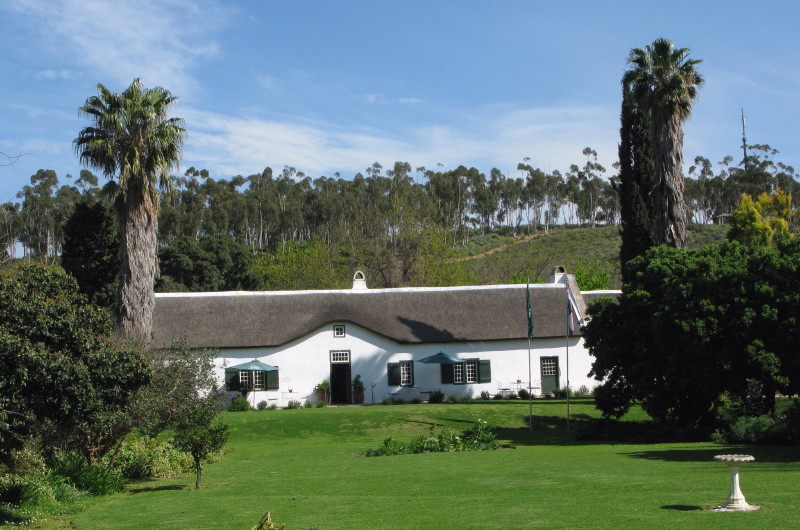
#23 This is way down alongside the river. It is now the Paddagang restaurant. (Lovely name.)
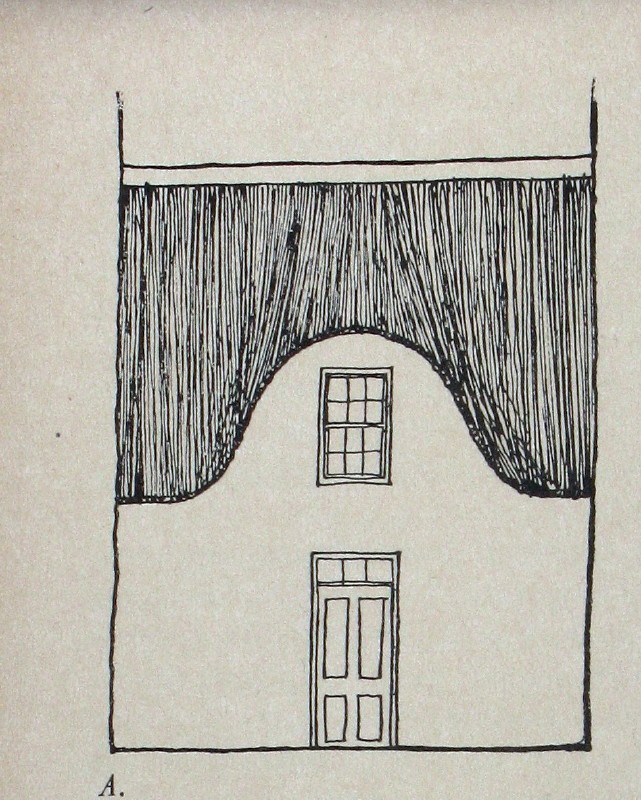
De Bosdari (he was British) calls this simple style ‘Leg of Mutton’. Hans Fransen in ’The Old Buildings of the Cape’ calls it a dormer gable. He explaines that the gables came into being in Cape Town where the plots were wide in comparison to in the Netherlands so the houses were built with the long edge facing the street (whereas in the Netherlands the short edge faces the street & you have a deep narrow house). To get light into the attic a dormer window was required because the end gables were right up against the neighbours end gable so no light would come in there. This is the simplest dormer gable with a window to give some light into the attic but soon it was made into an architectural feature and became the face and focus of the house. When the colony expanded away from the town this feature was retained and a local architectural characteristic had become established. I have also read that a full height gable (ie it goes above the thatch) makes the rain water not run down over the front door.
Note that Paddagang has casement (hinged) windows – not sliding sashes. You will see that several of the houses in Kerkstraat have casement windows. That was the usual type of window originally.
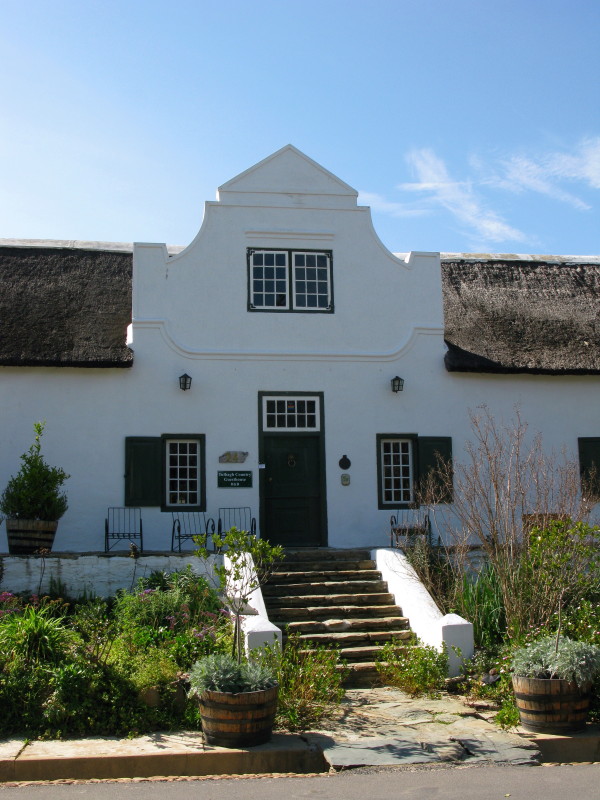
#24 A Neo-Classical gable but more developed and of nicer proportions (it is wider than it is high) than at #21. This broad Neo-Classical gable style was a variation used in the Breede River valley & Ceres area only. Casement windows again. Double sized windows to give more light into the loft. This is a rather grand house with another wing behind it and another piece added to the side so it has two doors onto Kerkstraat. In plan view it is H shaped, the only one in Tulbagh (excluding modern buildings). One of the long sides of the H faces the street and the cross bar of the H links the front wing to the rear wing.
This house was given a complete corrugated iron roof which also covered the courtyards between the front and rear wings so they became additional rooms. The gable over the front door was clipped so that a piece of corrugated iron roof could be fitted over it, thus the window was retained to give light in the attic. Gawie Fagan restored it to how it had originally been built.
Pillasters are the plaster mouldings on the face of the house which have the shape of (usually square) pillars but are just a decorative moulding about a hands depth out from the wall giving the appearance of a pillar. This house does not have them yet it has what looks like the top of pillars each side of the gable. If pilasters had been applied to this gable running down from what looks like the top of them each side of the gable they would have run right next to the windows each side of the front door behind the shutters. I mention this here because we will meet them again on some of the following houses.
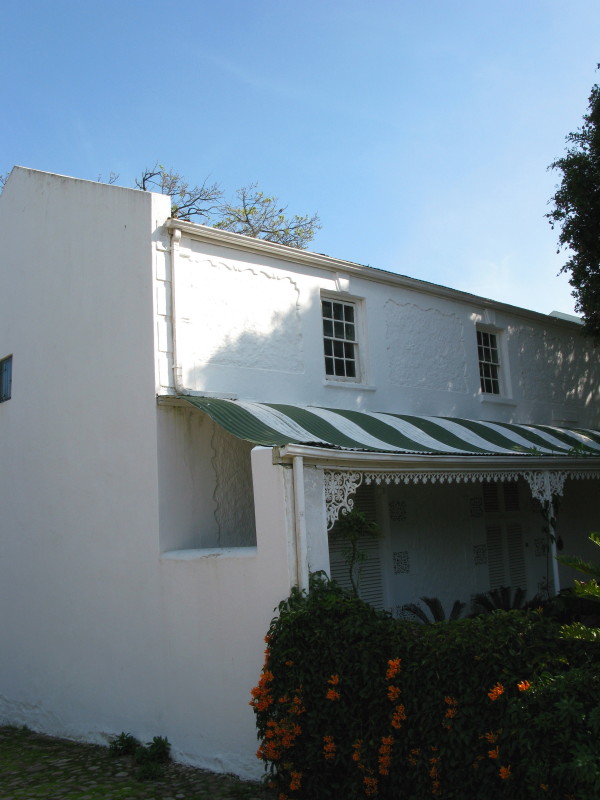
#25 This house was built in 1814 but it set a new pattern. Most houses are built single rooms deep in letter of the alphabet patterns of U, T, H or L. That is set by the limited length of the poles that could be got to span the walls (tie beams) and make the roof because the thatch needed to be at about 45 degrees so that water ran off it reliably. Also the wider the room the higher the roof needed to be. The letters of the alphabet describe the arrangement of the rooms (shape of the roof in bird’s eye view).
#25 was two rooms deep under a single roof so it had a simple square shaped roof in bird’s eye view. The roof was thus higher than usual but it set a fashion and other similar houses were built in Tulbagh after this. #4 & #10 and some of the other houses at the start of this report were followers of this new fashion – much easier once corrugated iron was available.
The Restoration Committee decided to preserve this house as it was after it had been updated with a corrugated iron roof, iron roof over the stoep and sash windows (originally casement) and the attractive plaster decoration on the front wall. Architects refer to the layering of a building – there are layers of embellishment that are applied to a building as it serves different people with different needs and different materials and fittings become available and fashions change. A building is not a static thing, nor is a village or town. So, when restoring a building, they have to decide to what period of its existence it is to be restored to and that is not always the oldest or original state. Here is a nice example of a building which has been restored to as it was after the owner had put a lot of effort and money into upgrading it. This Victorianisation was done by Mr C.C.Koch & he had his initials moulded into the plaster as he was so proud of what he had done. Unfortunately the trees have grown up so I could not get a good photo of the house.
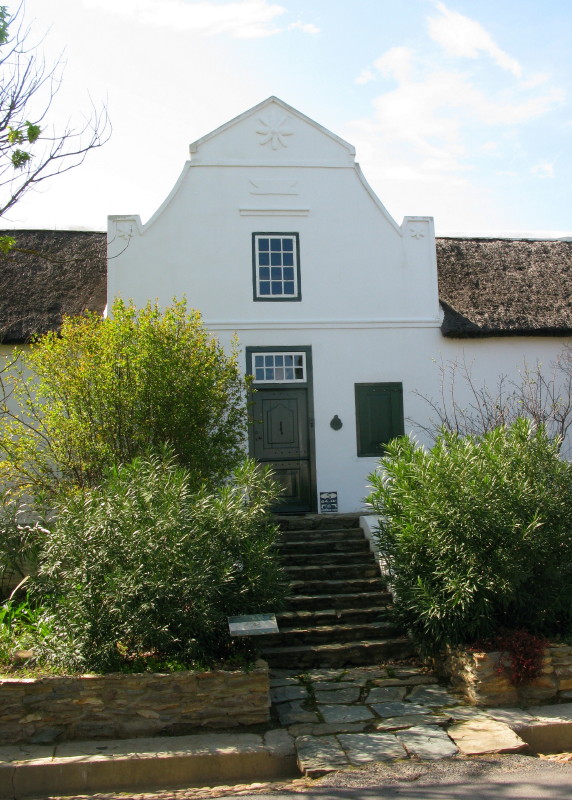
#26 This house had a very low pitched corrugated iron roof and verandah. The Fagan book does not say anything about this gable and it seems that the building had already lost it at the time of the 1861 photo. This is another of the local variations of the Neo-Classical gable (like #24). A more developed neo-classical shape with the straight sides further above the bottom of the thatch and only the slightest of curves to the sloping sides. Nice flower motif at the apex and at the top of the sides. The sides are starting to take on the shape of pillars. Again the tops of pilasters are shown but without actual pilasters underneath them.
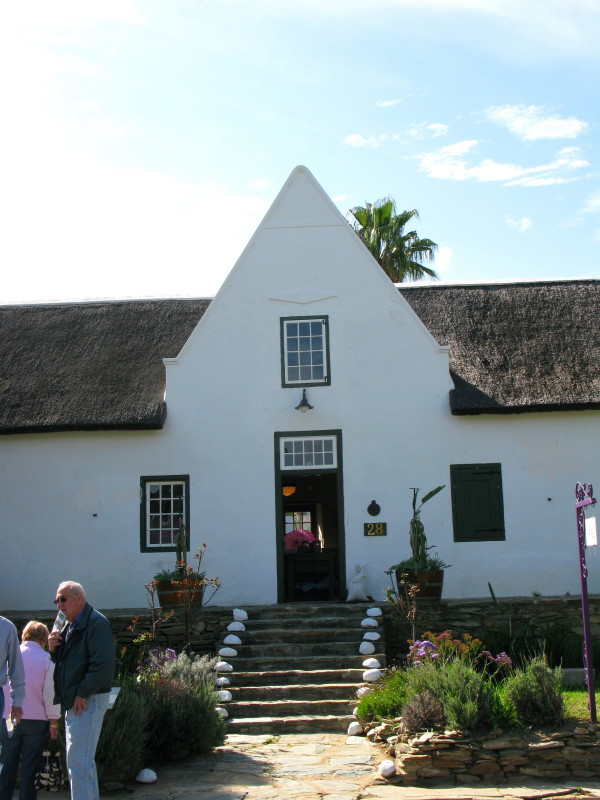
#28 This building had a hipped corrugated iron roof fitted in the early 1900s. A hipped roof is one without gables at the ends so it has the usual sloping front and back but the two ends are also sloping.
*source*
The house was restored to its original form with a thatch roof but the gable over the front door is unusual because it is much higher than the top of the roof so it has this tall triangular shape. It is very similar to #17 but does not have the nice semicircular top. You can also see the family resemblance to #21 but here the side pilasters have not grown as tall and anyway the windows each side of the front door would have been right in their way. The diamond pattern above the window of #21 is there. The end gables of this house are half-hipped; that is there are no proper gables there but it starts as a hipped roof but ends up like the gable over the front door of Paddagang.

#30 Now this is my favourite sort of gable. It is a development from the early holbol[/] gables but the mason has embellished it by extending the moulding of the bol onto the face of the gable and also making the pediment more decorative. This one is not done justice by having the sun behind it; can you see the three pineapples?
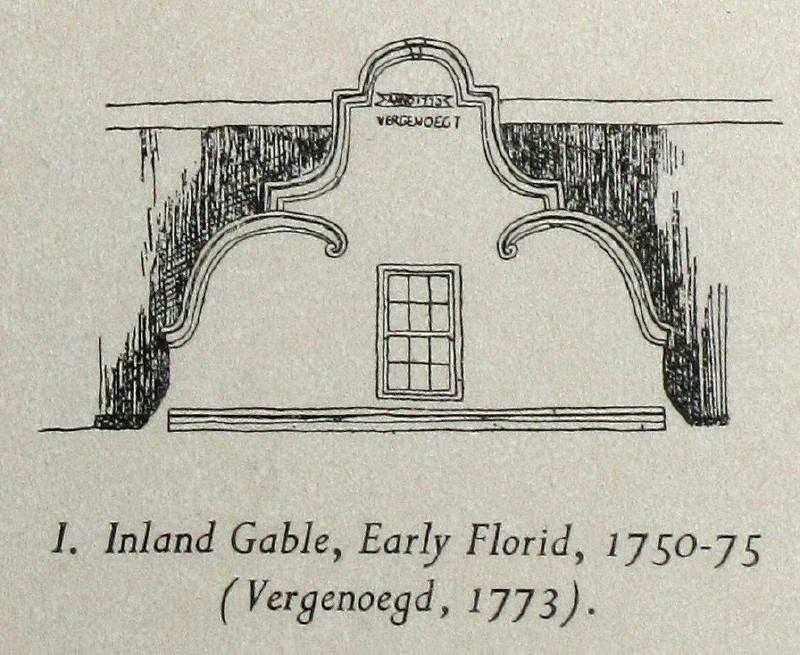
Here is an earlier version of this style where the apex (pediment) has not been made so elaborate.
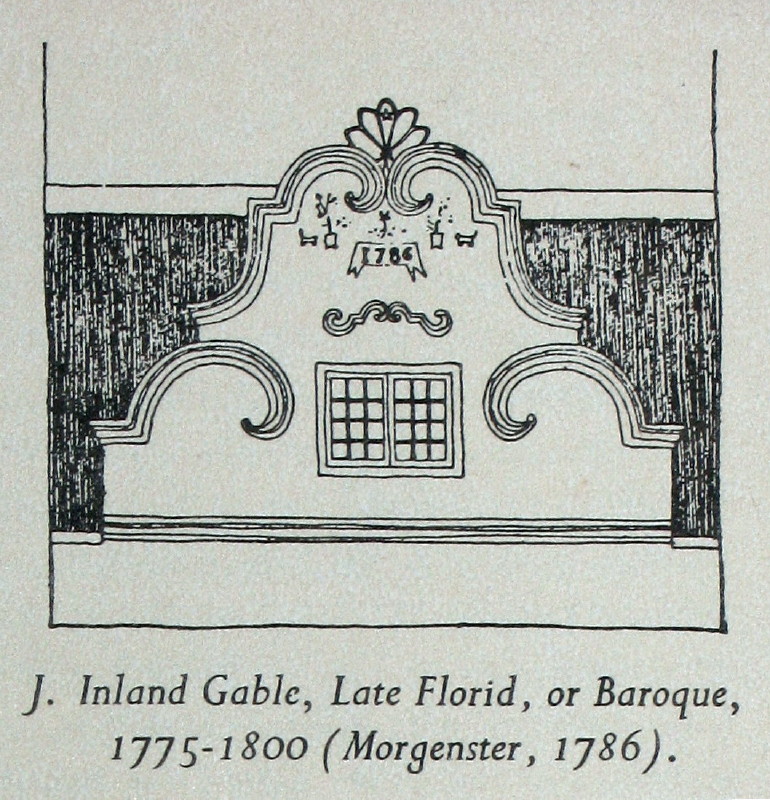
Here it has been taken further and is quite similar to #30. This is Morgenster in Somerset West and is one of my favourites – not least because it was built by the forefather of all the Malans here in South Africa, Jacques Malan & I am one of his descendants so I am somewhat biased. *Morgenster*
This the holbol or curvilinear style of Cape Gables is, in my humble opinion, much prettier than the angular & more formal later Neo-Classical style. I want you to appreciate that each gable is slightly different and they went through fashions and the man who was actually doing the plastering expressed himself in his interpretation of the design. There is, to me, a beautiful richness in this style; something like a voluptuous woman. Those skinny undernourished neo-classical models just don’t have what these have in my opinion. Notice the three pineapples as decorations on this gable. The top of this gable is very similar, but simpler, to the Morgenster gable. The shell motif at the top there is to be found on many gables.
Closer to Cape Town this form of gable went out of fashion in 1791 but to the east of the mountains they continued to be built for several years after that. This one was built in 1796.
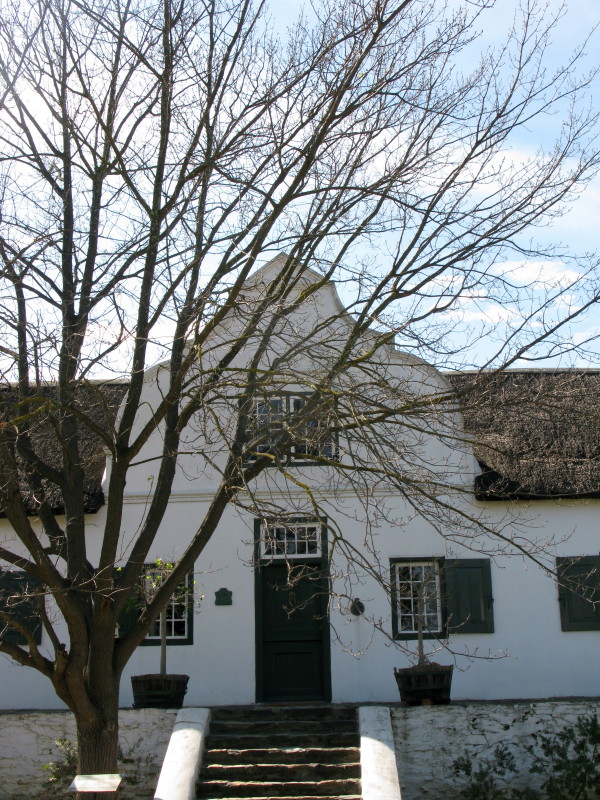
#32 Here is a more transitional gable. It has the curvilinear holbol sides but the apex is a straight edged triangle as favoured in the neo-classical. Before the earthquake it was a very simple house with a low pitched corrugated iron roof going over the end walls and a corrugated iron veranda with cast iron pillars and a nice Victorian cast iron and plastered brick fence at the street. Luckily the tree had no leaves when I took this photo. There is a tree in the 1861 photo which obscures the gable so Gawie Fagan chose to give it this gable as it fits the date of 1801.
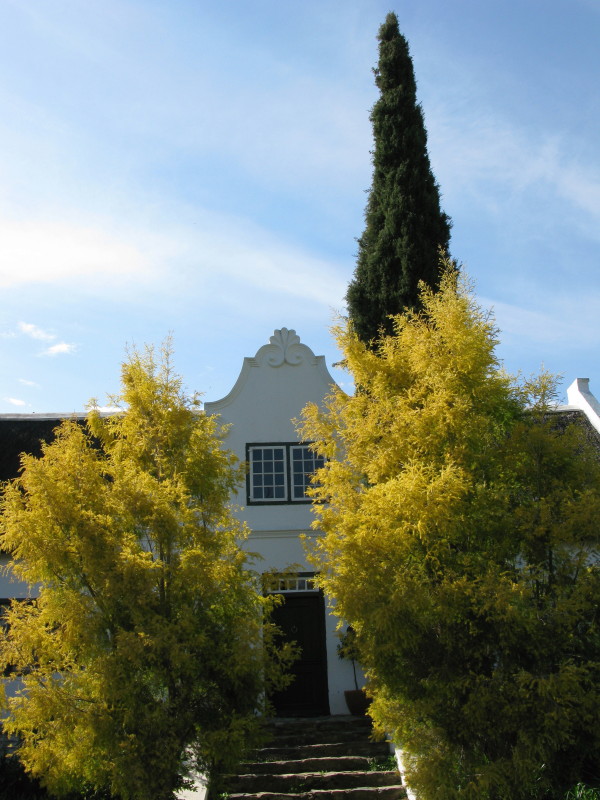
#34 You can’t see it from this photograph, because of the trees, but this gable is quite similar to #30. The curves of the bol moulding don’t come as far across the face and are much tighter. This illustrates how it was most probably the same mason who did both & here he gave a slightly different interpretation of the same tune, you can see the similarity but also the variation on the theme. That is very much part of the beauty and charm of the Cape Dutch gables – their individual character but family connection. In fact Gawie Fagan could only vaguely see the gable in the 1861 photo so he did a variation of the gable on the church. I will discuss that building after we get to the end of Kerkstraat.
This was a U shaped house originally. It had all its gables clipped off and a very simple corrugated iron roof fitted with the simplest windows into the loft. A corrugated verandah and brick plastered wall along the street with factory made little concrete pillars – the forerunners of ‘Vibracrete’.
#36 When I took the photos of the gables my idea was to simply write about the different gable styles. So I did not take a photo of #36 because there is no gable on it. When I came to do this write up I thought it much better to be inclusive so I have linked this photo from the internet at http://www.tulbagh.net/index.htm
It was built about 1812 pretty much as it now stands. In 1949 it was restored which included removal of a corrugated roof on the veranda. It was bought on auction in 1964 and the new owner named it ’Monbijou’ (My Jewel). Although this is the only double storey house in the street houses like this were being built in Cape Town at that time eg Koopmans de Wet house in Strand Street. Fashions change and this house represents what was current when it was built and adds variety to the record that is this street. Note that it has sliding sash windows.
I remember the controversy when the new owner painted the house pink with the pilasters and mouldings in white. Many said that it was not authentic but the Fagan book points out that the colours are ‘not out of keeping with similar houses of the period.’ In Strand Street in Cape Town there are three exceptional buildings on the right just before Buitengraght street. The Gold of Africa Museum (#96), the Lutheran Church & the Netherlands Consulate General. First the Gold Museum was painted a pumpkin colour which was a huge surprise – it has since been painted a less surprising shade of yellow. In the last few months the Netherlands Consulate has been painted the same colour but a few shades lighter and now the Lutheran Church is being painted pink & white just like Monbijou. Here is the church in van Wyksdorp photographed by TR in the same colour scheme. It compliments the plasterwork so it is better appreciated. It is not a new fashion as Gawie Fagan noted.
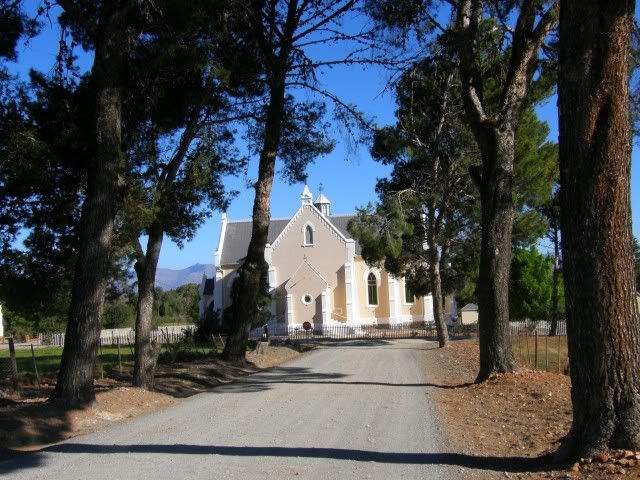

#38 This house was partly demolished by the owner after the earthquake before the Restoration Committee bought it. It has been restored to what it was like when built. A humble house without a gable which adds to the variety represented in this street.
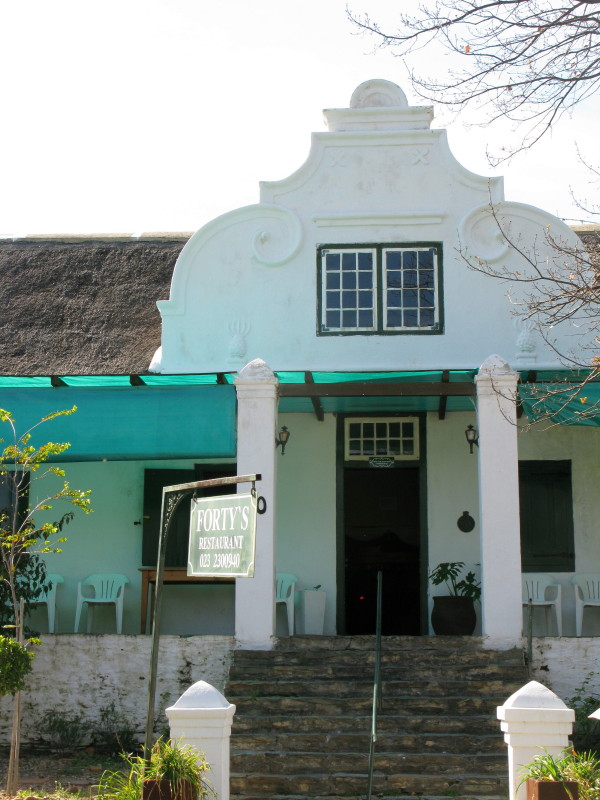
#40 This house had been given a corrugated iron roof and veranda with cast iron pillars. It has been restored to how it looked when built in 1796. The gable can be seen in the 1861 photo indicating it was similar to the one on Leeuwfontein nearby so that was used as a guide for this gable (not a direct copy). Another gable that is much wider than it is high allowing a double sized loft window as well as making space for elegant curved extension of the bol moulding. Pineapples on the face again; I don’t know why that fruit was used but Antonia may know so I will ask her. The pergola over the stoep is authentic. When the house was Victorianised it had sliding sash windows fitted but hinged casement windows have been restored to it. The house is H shaped but the back wing is not full length.

#42 The house was built in 1796 or soon thereafter. There was a good sketch of this house done by Burchell in 1811. It shows the left hand end (north) gable with the front gable in very oblique view but clearly very similar and the pergola over the stoep. It can also be vaguely seen in the 1861 photo. The house had been Victorianised with a corrugated iron roof, very raised walls and quite big windows upstairs (it was now double storied) as it was used as a boarding house for the school over the street. When the plaster was stripped off all the walls during restoration the position and size of the original windows and doors could be seen & it was found that this house originally had sliding sash windows. On early sash windows the upper panel is fixed and only the lower sash slides; that is how the building has been restored. The gable is very similar to #24 & #26. You still have the hol curves but the bols have gone. This is well on the way to a full neo-classical gable and Gawie Fagan chose to give it festoons such as above the date at Nectar.
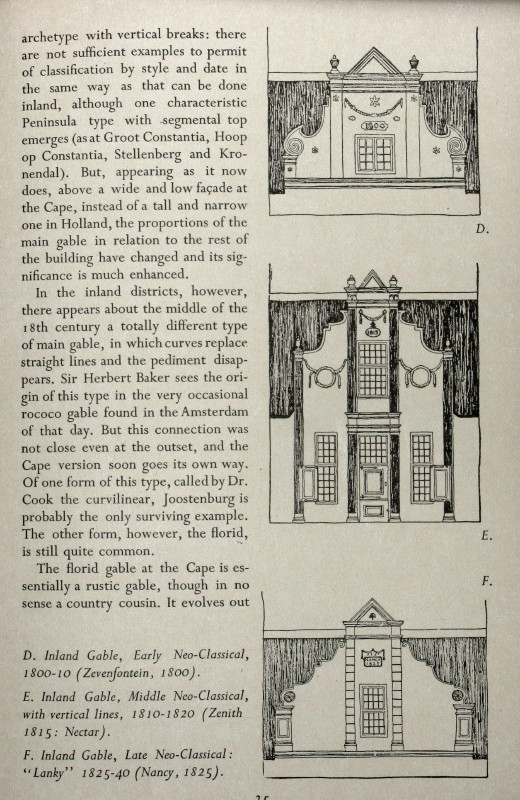
This is a page from the de Bosdari book showing neo-classical gables. I am pleased that there is such variety in the gables but the geometric formality of the Nectar gable just does not please me as much as the flowing voluptuous Morgenster gable. We are fortunate to have this rich variety and are free to have our personal preferences. I have no trouble with those who prefer Nectar to Morgenster. Taste and preference is a personal thing, not a judgement. Kudos to Gawie Fagan for including this in Kerkstraat.

#43 Ballotina This building does not actually front onto Kerkstraat so I did not photograph it. Now that I come to write this up I find it was, at one time, the school served by #42. This photo is from the internet at http://www.artefacts.co.za/main/Buildings/bldgframes.php?bldgid=11&source=0
You can see that the side gable facing Kerkstraat is a simple holbol whereas the front gable is a variation on that same theme but the top is reminiscent of Groot Constantia. It got a corrugated iron roof but the gables were not removed. It also got the ubiquitous corrugated stoep roof which was removed during the restoration.
This house was bought by Dr Mary Cook in 1945 and remained hers until her death almost 40 years later. That we have so many Cape Dutch gabled buildings today is to a huge extent thanks to her and Hans Fransen. She was born in Yorkshire, England in 1902, trained as a medical doctor and married a priest. They moved to the Transvaal in 1926.
Quote:
During the family holidays in the Western Cape, Mary was fascinated by Cape architecture, and she studied the topic thoroughly, taking also notes in the archives. She started campaigning for the preservation of Cape architecture and, from 1947, she wrote regularly on the subject in journals and newspapers. The family moved to the Strand and later to Kalk Bay, Cape Province. After the early death of her husband in 1957, she devoted her energies to the preservation of antiques. In 1958 she accepted a post as historical researcher at the SA Museum in Cape Town, which put her in charge of the cultural history section. The Koopmans de Wet House became subsequently the South African cultural History Museum. In 1965, Mary Cook accepted the position of curator of the Swellendam Drostdy Museum, which she remained until her retirement in 1974. A year later she moved to Tulbagh, where she had bought, in 1945, the beautiful old house Ballotina in Church Street. Her attempt to restore this house remained incomplete. Mary Cook died on 2 August 1981 while on visit to her daughter's house in Somerset West.
*source* Together with Hans Fransen (our guide for this trip) she wrote The Old Houses of the Cape published in 1965. They entirely revised and much expanded on that book , published in 1981 as The Old Buildings of the Cape. We have a copy of that book; here is what is written on the inside flyleaf:
Quote:
The appearance in 1965 of THE OLD HOUSES OF THE CAPE by two well-known Cape museum curators, Hans Fransen and Dr Mary Cook, was an epoch-making event. For the first time, an attempt had been made to compile a full survey of the old architecture of the Cape, with architectural as well as historical descriptions and authoritative introductions on the Cape gable and groundplan. The book went out of print within a few years and today is valuable Africans. Ever since its appearance, the authors set revising their work, and Hans Fransen was responsible for expanding its terms of reference and including hundreds of new gable diagrams, groundplans and halftone illustrations. The second edition of their book, now entitled THE OLD BUILDINGS OF THE CAPE to reflect its new scope, now covers most significant buildings from the period up to the end of the 19th Century, and thus includes not only Cape Dutch but also Georgian, Regency and Victorian architecture. The area covered is still that bordered by Calvinia in the North and Colesberg and Uitenhage in the East. Well over two thousand old buildings in this area are listed, most of these with architectural descriptions, and many also with historical notes. Illustrations include over 400 photographs, 154 site and house plans, 32 town plans and 10 area maps. The introductory chapter on the Cape gable now has 112 diagrams of gables. Even more so than its predecessor, THE OLD BUILDINGS OF THE CAPE is the definitive survey of the extant buildings in this area, and an indespensible field guide to all serious students of the subject.
They did for old Cape buildings what Roberts did for our birds & Platter for our wine.
Years before the earthquake Dr Mary Cook saved some old sash windows which she found as part of an old hen house on a farm nearby. When the house was restored they fitted exactly into the original window reveals.
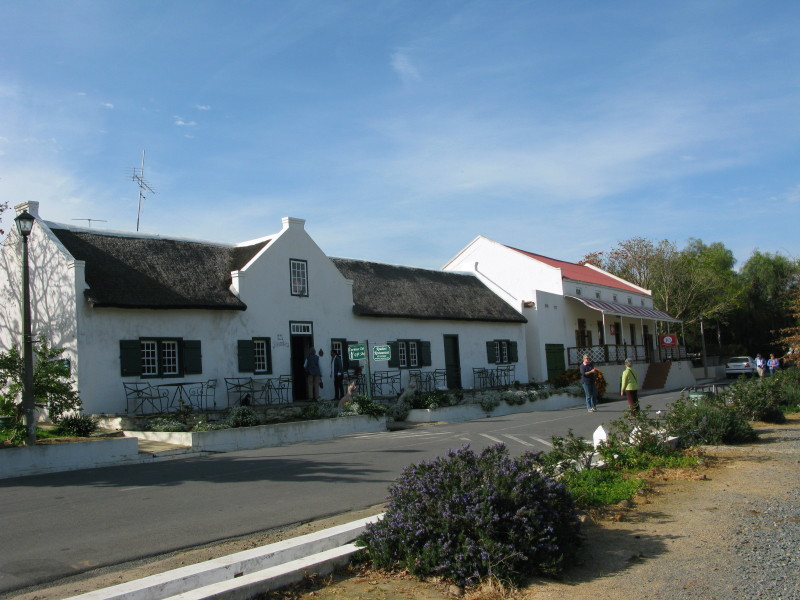
Let us now walk back down to the church at the other end of Kerkstraat. I did not take a photograph of the parsonage (pastorie) which is right at the focus of Kerrkstraat on the far side of the t-junction. It too is a handsome holbol gabled building.
Look at this picture of #12 with #10 next to it. It shows a house representing those that were originally built with a gable over the front door and thatch roof. Next to it is a Victorian house with corrugated iron roof and ogee corrugated iron roof over the veranda (stoep). The floor level of #10 is much higher than #12 but you can still clearly see how much taller the walls of the Victorian building are compared to the thatch roofed predecessor. With the passage of time buildings get renovated & remodelled according to the current fashion. What started as a thatch roofed house with gables changed, when the roof needed replacing, because the owners took the opportunity to convert to a modern corrugated iron roof. A thatch roof has to be steep to prevent the water from seeping through. A corrugated iron roof can be much flatter; this also reduces the length of the sheets needed so saves money. The side gables get cut down so the corrugated iron goes over the top of the end walls thus protecting the unfired mud bricks from the rain. At the same time the walls are raised along the long front & back sides and the gable over the front door is cut right off. Now a simple cheap corrugated iron roof can be fitted and the loft (attic) is much bigger because it now has the short wall above the floor of the loft with the windows you see in the photo (the thatch roofs sloped right down to the floor of the attic = brandsolder). The Victorian house has the ogee curved corrugated iron roof over the stoep. The original thatch roofed house has a roof that comes down to the level of the brandsolder. The extension of the wall with the windows above it is the new extra height that has been added. You can also see how much flatter the corrugated iron roof is than the old thatch roof.
We have an interesting comparison of architectural styles in this street and Bain Street in Wellington. Bain Street has been preserved with the Victorian corrugated iron style whereas Kerkstraat has been restored to the previous thatch roofed and gabled style. Bain street was originally similar to Kerkstraat but after a fire in 1875 almost all the houses were burnt down. They were rebuilt in the Victorian style and remain like that today. In this post I show some of the Bain Street buildings. Here in Kerkstraat those Victorian renovations have been undone to restore the previous buildings.
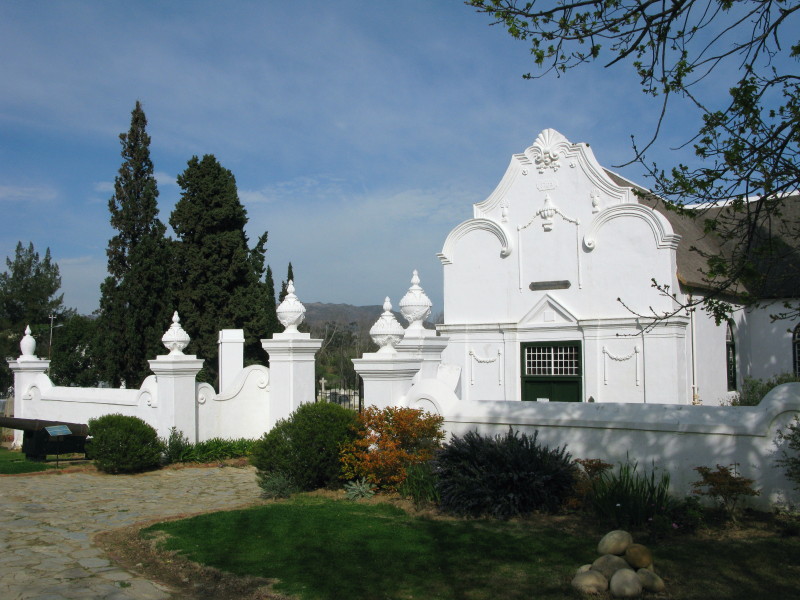
This is the original church which is now a museum. It is the oldest church building in the cape that is more or less as it was when built. Selling the erven along Kerkstraat raised money for enlarging this church; the part you see here is that addition so a lot of the money was spent on this gable. A wonderful holbol with a shell in the apex and festoons below. I particularly want to draw your attention to the curve of the extension of the bols into the face as I will show a different version of this at the end of this thread. The festoons each side of the door are roses.
The date on the gable is 1795 which is when the church was enlarged (only 3m longer). Before the earthquake the date was 1743 (when the church was originally built) but Gawie Fagan took the opportunity to correct the date when doing the restoration. There is a drawing and a photograph (by Arthur Elliot) of the gable where it was 1795 and that was changed some time after it was built using grey cement for the last two digits whereas the original bits are in pale plaster. (I will talk about gable dates at the end of this thread.)
The style of this gable is interesting because it has the old holbol shape but it also has the neo-classical decorations (the urn and festoons). A somewhat confused transitionary gable but exceedingly fine I think.

,
1 comment:
hey your blog design is very nice, clean and fresh and with updated content, make people feel peace and I always enjoy browsing your site.
- Norman
Post a Comment